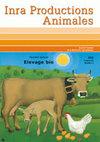家畜表型的参考语言:ATOL本体论
IF 0.6
4区 农林科学
Q3 Agricultural and Biological Sciences
引用次数: 3
摘要
最近的技术进步允许生产大型生物数据集,使表型的描述更加准确。为了用计算机分析大量的信息并比较表型,有必要定义一种明确定义表型特征的标准语言,以便在全球范围内为任何可能的用户(遗传学家、生理学家、生物化学家、建模师、生产者……)提供参考。由于牲畜物种缺乏这样的语言/参考,Inra与其国际合作伙伴合作开发了一种称为ATOL(牲畜动物特征本体)的本体。其目的是定义家畜物种的表型特征,并将其分配到不同的类型:性能性状(饲料效率、肥力)、生产性状(乳、肉、蛋、脂肪肝)和社会性状(福利)。本文总结了该项目的目标、构建本体的原始方法,以及它的现状和性能以及它的局限性。这个本体论在网络上公开可用,并期望在全球范围内广泛共享,以共同使用独特的术语来注释出版物,数据库或挖掘文献,从而促进系统和预测生物学。本文章由计算机程序翻译,如有差异,请以英文原文为准。
Un langage de référence pour le phénotypage des animaux d’élevage : l’ontologie ATOL
Recent technological advances allow the production of large biological datasets that makes the description of phenotypes more accurate. To analyze this huge amount of information with computers and thus compare phenotypes, it is essential to define a standard language that unambiguously defines phenotypic traits so as to serve as a reference, worldwide, to any possible user (geneticist, physiologist, biochemist, modeler, producer...). The absence of such a language/reference for livestock species has led Inra, in collaboration with its international partners, to develop an ontology that is called ATOL (Animal Trait Ontology for Livestock). Its aims are to define the phenotypic characters of livestock species, and allocate them to different types: performance traits (feed efficiency, fertility), production traits (dairy, meat, eggs, fatty liver) and societal traits (welfare). This article summarizes the objectives of the project, the original approach used to build the ontology, but also its current status and performance as well as its limitation. This ontology is publicly available on the web and expected to be widely shared worldwide for the common use of unique terms to annotate publications, databases or mine literature and thus promote systemic as well as predictive biology.
求助全文
通过发布文献求助,成功后即可免费获取论文全文。
去求助
来源期刊

Inra Productions Animales
Multiple-
CiteScore
1.30
自引率
33.30%
发文量
0
审稿时长
>36 weeks
期刊介绍:
This journal publishes scientific update reports, results of experiments and their possible applications, analyses on topical issues and presentation of research, information on scientific events and new publications.
INRA Productions Animales deals with all species of zootechnical interest (herbivores, monogastrics and fish), covering feed and nutrition, physiology, pathology, genetics, production techniques, product quality and production economics.
 求助内容:
求助内容: 应助结果提醒方式:
应助结果提醒方式:


